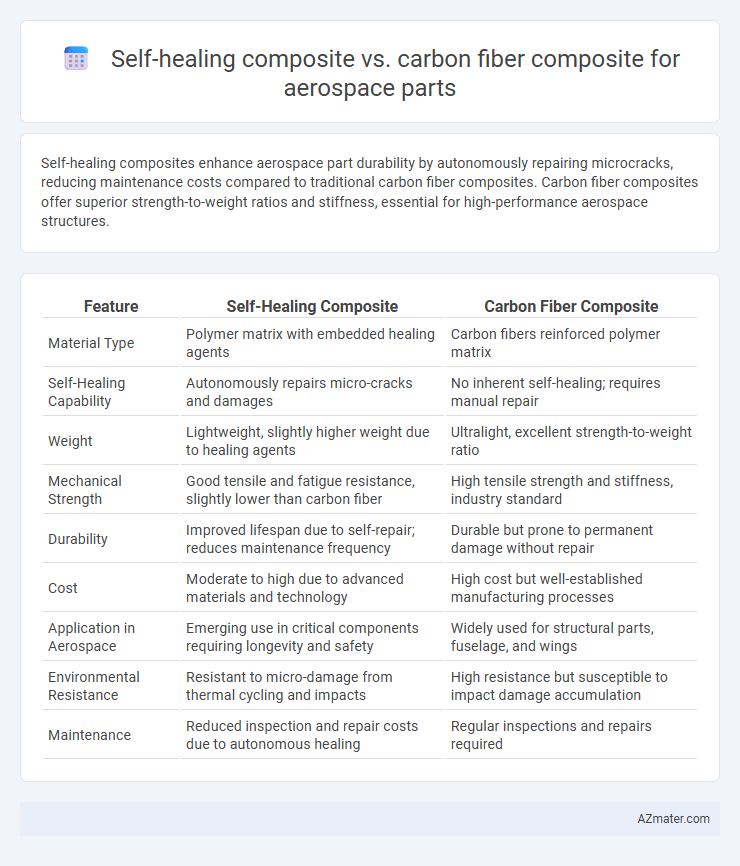Self-healing composites enhance aerospace part durability by autonomously repairing microcracks, reducing maintenance costs compared to traditional carbon fiber composites. Carbon fiber composites offer superior strength-to-weight ratios and stiffness, essential for high-performance aerospace structures.
Table of Comparison
| Feature | Self-Healing Composite | Carbon Fiber Composite |
|---|---|---|
| Material Type | Polymer matrix with embedded healing agents | Carbon fibers reinforced polymer matrix |
| Self-Healing Capability | Autonomously repairs micro-cracks and damages | No inherent self-healing; requires manual repair |
| Weight | Lightweight, slightly higher weight due to healing agents | Ultralight, excellent strength-to-weight ratio |
| Mechanical Strength | Good tensile and fatigue resistance, slightly lower than carbon fiber | High tensile strength and stiffness, industry standard |
| Durability | Improved lifespan due to self-repair; reduces maintenance frequency | Durable but prone to permanent damage without repair |
| Cost | Moderate to high due to advanced materials and technology | High cost but well-established manufacturing processes |
| Application in Aerospace | Emerging use in critical components requiring longevity and safety | Widely used for structural parts, fuselage, and wings |
| Environmental Resistance | Resistant to micro-damage from thermal cycling and impacts | High resistance but susceptible to impact damage accumulation |
| Maintenance | Reduced inspection and repair costs due to autonomous healing | Regular inspections and repairs required |
Introduction to Aerospace Composites
Aerospace composites such as carbon fiber composites are widely used for their high strength-to-weight ratio and excellent fatigue resistance, making them ideal for structural aerospace parts. Self-healing composites incorporate microcapsules or vascular networks to autonomously repair damage, enhancing durability and reducing maintenance costs in critical aerospace components. These innovations aim to extend the lifespan and improve the safety of aerospace structures by minimizing the risk of catastrophic failures caused by microcracks or delamination.
Overview of Carbon Fiber Composites
Carbon fiber composites consist of carbon fibers embedded in a polymer matrix, offering exceptional strength-to-weight ratios and high stiffness crucial for aerospace applications. These materials provide excellent fatigue resistance, thermal stability, and corrosion resistance, making them ideal for structural components in aircraft and spacecraft. Advanced manufacturing techniques enhance their customization and performance, ensuring reliability under extreme aerospace conditions.
Fundamentals of Self-Healing Composites
Self-healing composites incorporate microcapsules or vascular networks containing healing agents that activate upon damage, restoring structural integrity autonomously, which contrasts with traditional carbon fiber composites relying solely on initial material strength. These advanced materials significantly enhance durability and safety by preventing crack propagation and reducing maintenance needs in aerospace components. The self-healing mechanism involves chemical reactions triggered by environmental factors or mechanical stress, optimizing composite lifespan without compromising the lightweight, high-strength characteristics essential in aerospace applications.
Comparative Mechanical Properties
Self-healing composites exhibit enhanced damage tolerance by autonomously repairing micro-cracks, improving fatigue resistance and extending service life compared to traditional carbon fiber composites. Carbon fiber composites offer superior tensile strength and stiffness, making them ideal for load-bearing aerospace structures but are prone to irreversible damage under impact. The choice between self-healing composites and carbon fiber composites depends on balancing mechanical performance with maintenance requirements in aerospace applications.
Durability and Damage Resistance
Self-healing composites exhibit enhanced durability for aerospace parts by autonomously repairing micro-cracks, significantly extending service life compared to traditional carbon fiber composites. Carbon fiber composites offer high strength-to-weight ratios but are more susceptible to irreversible damage from impact and fatigue, requiring manual inspection and repair. Integrating self-healing capabilities reduces maintenance costs and downtime, improving overall damage resistance critical for aerospace applications.
Maintenance and Lifecycle Costs
Self-healing composites significantly reduce maintenance frequency and costs for aerospace parts by autonomously repairing micro-cracks, enhancing durability and operational lifespan. Carbon fiber composites offer high strength-to-weight ratios but require extensive inspections and manual repairs, leading to higher lifecycle maintenance expenses. Integrating self-healing technology in aerospace materials optimizes total lifecycle costs by minimizing downtime and extending service intervals compared to traditional carbon fiber composites.
Weight and Structural Efficiency
Self-healing composites in aerospace applications offer enhanced structural efficiency by autonomously repairing micro-cracks, significantly extending service life without adding substantial weight. Carbon fiber composites maintain superior strength-to-weight ratios, delivering high stiffness and durability essential for weight-critical aerospace components. Balancing weight reduction with damage tolerance, self-healing composites provide innovative advantages over traditional carbon fiber materials in improving aerospace structural performance.
Manufacturing Processes and Scalability
Self-healing composites utilize advanced resin systems embedded with microcapsules or vascular networks that autonomously repair damage during service, requiring specialized manufacturing processes such as controlled curing and precise microencapsulation techniques, which can introduce complexity and higher production costs compared to traditional methods. Carbon fiber composites rely on established processes like automated fiber placement (AFP) and resin transfer molding (RTM) that enable high-volume, repeatable production with superior mechanical properties, making them highly scalable for aerospace applications. While self-healing composites offer enhanced longevity and damage tolerance, their manufacturing scalability remains limited due to intricate processing steps and material costs compared to the more mature, efficient, and widely adopted carbon fiber composite manufacturing technologies.
Environmental Impact and Sustainability
Self-healing composites reduce waste and extend the service life of aerospace parts by autonomously repairing micro-damage, significantly decreasing the need for replacements and lowering environmental footprints compared to traditional carbon fiber composites. Carbon fiber composites, although lightweight and strong, pose sustainability challenges due to energy-intensive manufacturing and limited recyclability, leading to persistent environmental burdens. Integrating self-healing properties enhances resource efficiency and supports circular economy principles critical for sustainable aerospace manufacturing.
Future Trends in Aerospace Composite Materials
Self-healing composites show promising advancements in aerospace by enhancing durability and reducing maintenance costs through the ability to autonomously repair micro-damages, thereby extending the lifespan of components. Carbon fiber composites continue to dominate with superior strength-to-weight ratios and thermal stability essential for high-performance aerospace applications. Future trends emphasize hybrid composites integrating self-healing capabilities with carbon fiber's mechanical properties to optimize safety, performance, and sustainability in next-generation aerospace parts.

Infographic: Self-healing composite vs Carbon fiber composite for Aerospace part
 azmater.com
azmater.com